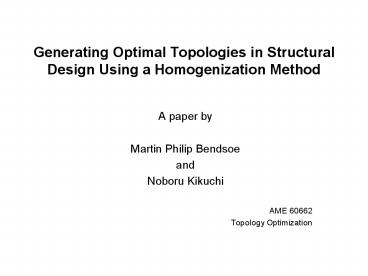Generating Optimal Topologies in Structural Design Using a Homogenization Method - PowerPoint PPT Presentation
1 / 22
Title:
Generating Optimal Topologies in Structural Design Using a Homogenization Method
Description:
The method consists of getting an optimal distribution for anisotropic space ... The proposed optimization method can provide the optimal shape as well as the ... – PowerPoint PPT presentation
Number of Views:263
Avg rating:3.0/5.0
Title: Generating Optimal Topologies in Structural Design Using a Homogenization Method
1
Generating Optimal Topologies in Structural
Design Using a Homogenization Method
- A paper by
- Martin Philip Bendsoe
- and
- Noboru Kikuchi
- AME 60662
- Topology Optimization
2
Basic Concept
- The method consists of getting an optimal
distribution for anisotropic space which is
constructed by introducing small periodically
distributed holes in a homogeneous, isotropic
material such that it satisfies all the required
constarints.
3
Basic Approach
- The structural element is taken as being defined
only by - The loads it is supposed to carry
- Its volume (cost)
- Stress and strain limitations
- Note Restriction on allowable shapes is that the
element should connect to the given surface
tractions.
4
Optimal Design of Linearly Elastic Structures
- Seeking minimum compliance is equivalent to
finding optimal elasticity tensor Eijkl for a
given set of admissible elasticity tensors Uad
where Uad (L8(O)). - The minimum compliance takes the form
5
Cont
- Where
6
1. For Optimal Shape design
- Indicator function
- 2. For Optimal Sizing Problems
- Sizing Function
7
Stepwise Method
- Suitable reference for defining surface tractions
and fixed boundaries. - Choosing a composite having periodic repetitive
unit cells with one or more holes - Using Homogenization Theory, get a functional
relationship between the density of material and
effective material properties. - Compute the optimal distribution of material in
the reference domain treating density as the
sizing variable. - Interpret the optimal distribution of material as
defining shape.
8
Homogenization Method
9
- The Finite Element Analysis is used on cell
element for getting homogenized elasticity tensor
which is applied for shape optimization.
Question??
Sensitivity of results with respect to FEM meshing
10
(No Transcript)
11
(No Transcript)
12
Conclusions from examples
- Its better not to replace holes by soft
materials when the goal is to find the
homogenized elasticity tensor. - The present study takes a cell structure with
rectangular hole. - Continuously varying size of rectangular hole is
to be taken to make density a design variable.
13
The Optimization Method
Homogenization method
- The problem of minimum compliance becomes
The design variables µ and ? are discretized. An
optimization scheme based on Optimality criteria
is constructed
14
Optimality Criteria
Where ? and ?i are Lagrange multipliers for
volume and density constraints.
15
Iteration used over µ and ? is
Where D is
16
Computational Results
- Two types of basic square cells were used
- One with square holes
- One with rectangular holes
- Note For both the cases optimization was
performed including and excluding cell
rotation
17
(No Transcript)
18
(No Transcript)
19
Comparing results obtained with and without the
cell rotation as a design variable. Case A with
voids as rectangular holes. Left-hand rotation of
voids, right-hand column not. Volumes are 91,
64 and 36
20
Results of the lumping process. Case A with voids
as square holes that can be rotated. Left-hand
column shows results prior to lumping, right-hand
column the resulting lumped designs. Volumes are
91, 64 and 36.
21
(No Transcript)
22
Conclusions
- The proposed optimization method can provide the
optimal shape as well as the topology of the
element. - The method is a material distribution method,
based on the use of artificial composite material
with microscopic voids.































